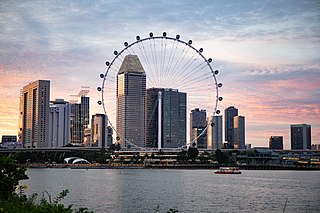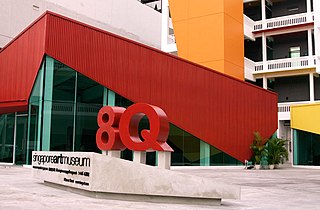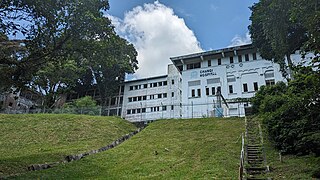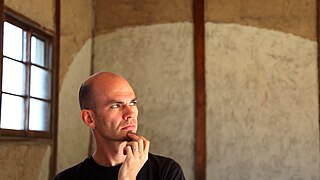
Marina Bay is a bay located in the Central Area of Singapore, surrounded by the perimeter of four other planning areas, the Downtown Core, Marina East, Marina South and Straits View. The area surrounding the bay itself, also called Marina Bay, is a 360 hectare extension to the adjacent Central Business District. It is also the new downtown of Singapore, built on reclaimed land.

The Singapore Art Museum is an art museum is located in the Downtown Core district of Singapore. It is the first fully dedicated contemporary visual arts museum in Singapore with one of the world’s most important public collections by local, Southeast and East Asian artists. It collaborates with international art museums to co-curate contemporary art exhibitions.

This article shows the notable future developments in Singapore. Most of them are currently under construction with most to be completed within the next five years.

The Museum Planning Area is a planning area located in the Central Area of the Central Region of Singapore. The area plays a "bridging role" between the Orchard area and the Downtown Core, which necessitates proper transport networks for vehicles, pedestrians and public transport. Due to the sheer size of green areas in the district, the Urban Redevelopment Authority (URA) has designated it a 'green lung' in the Central Area. However, the Museum Planning Area is also home to cultural and commercial activities. Around 65% of the area is available for future development, making it a hotbed for new infrastructure and buildings.

One-north is a subzone of Queenstown, Singapore, first developed by JTC Corporation as the country's research and development and high technology cluster. It was first conceptualised in 1991 as part of the National Technology Plan and officially launched on 4 December 2001 by then Deputy Prime Minister Tony Tan Keng Yam.

The National Gallery Singapore, often known exonymously as the National Gallery, is a public institution and national museum dedicated to art and culture located in the Civic District of Singapore. It oversees the world's largest public collection of Singaporean and regional art of the Eastern world, specifically of Southeast Asia, with a collection of more than 9,000 items.

The Fullerton Hotel Singapore is a five-star luxury hotel located near the mouth of the Singapore River, in the Downtown Core of the Central Area, Singapore. It was originally known as the Fullerton Building, and also as the General Post Office Building. The address is 1 Fullerton Square. The Fullerton Building was named after Robert Fullerton, the first Governor of the Straits Settlements (1826–1829). Commissioned in 1924 as part of the British colony's centennial celebrations, the building was designed as an office building by Major P.H. Keys of Keys & Dowdeswell, a Shanghai firm of architects, which won the project through an architectural design competition. The architectural firm also designed the Capitol Theatre, its adjoined Capitol Building and the Singapore General Hospital. In 2015, it was designated as a national monument of Singapore.

Gallery Hotel was a four-star boutique hotel at Robertson Quay on Singapore River, in the Central Area of Singapore. Originally known as Gallery Evason Hotel, it was the first "HIP" hotel in Singapore, and the second in Asia, the first being in Japan.

The culture of Singapore has changed greatly over the millennia. Its contemporary modern culture consists of a combination of Asian and European cultures, mainly by Chinese descents, South Asian, East Asian and Eurasian influences. Singapore has been dubbed as a country where "East meets West", "Gateway to Asia" and a "Garden city".

SAM at 8Q is the annexe of Singapore Art Museum - Singapore's contemporary art museum. Located at the heart of the city, it derives its name from the museum's location at No. 8 Queen Street near Bras Basah Road. SAM at 8Q is also approximately 88 steps away from Singapore Art Museum.

Baba House is a museum in Singapore, showcasing Peranakan history, architecture and heritage. It is a traditional Peranakan pre-war terrace-house which was formerly owned by the family of a 19th-century shipping tycoon Wee Bin who settled in Singapore, after arriving from the southern Chinese province of Fujian. The Baba House is also an outpost of the National University of Singapore (NUS) Museum and co-managed by the NUS Centre for the Arts.

Objectifs is an independent non-profit visual arts space in Singapore that aims to cultivate original voices in visual storytelling, and to inspire and broaden perspectives through the power of images. It presents a year round programme of exhibitions, screenings, residencies, developmental programmes, talks and workshops that advance the practice and appreciation of photography and film.

Changi Hospital is a now-defunct and abandoned general hospital located in Changi, Singapore. Its closure came with the merging with the former Toa Payoh Hospital and was renamed as the Changi General Hospital, which relocated new operations to nearby Simei, not far from Changi. It began winding down activities in February 1997 and remains abandoned to this day, but is off limits to the public.

Singapore Pinacothèque de Paris was a private art museum formerly located in the Fort Canning Arts Centre at Fort Canning Park, Singapore. It opened to the public on 30 May 2015 and had its last day of operations on 10 April 2016, citing "weaker than expected visitorship and other business and financial challenges faced".

NTU Centre for Contemporary Art Singapore is a national research centre affiliated with Nanyang Technological University (NTU).

Sculpture Square was a non-profit arts organization located at 155 and 161 Middle Road, Singapore. It was founded by sculptor Sun Yu-Li in 1995 as a venue with the focus on exhibiting and fostering ‘3-dimensional’ and other forms of sculptural arts in Singapore.
ShanghART Gallery is founded in 1996 by Swiss gallerist Lorenz Helbling as one of the first contemporary art galleries established in China. Initially operating out of a hotel, it has since expanded to four gallery spaces, two in Shanghai, and one each in Beijing and Singapore. For the past two decades, ShanghART has devoted to the development of contemporary art in China and kept close and long-term cooperation with more than 60 artists, building an audience for artists ranging from painters such as Yu Youhan and abstractionist Ding Yi, to artists midway through their career, Zhou Tiehai and Yang Fudong, as well as emerging artists like Zhang Ding and Chen Wei. The Singapore space in Gillman Barracks, established in 2013, extended their outreach to Southeast Asian artists such as Robert Zhao Renhui and Apichatpong Weerasethakul.

James Jack is a contemporary artist based in Japan.
Erika Tan is a London-based Singaporean contemporary artist and curator whose research-led practice emerges from her interests in anthropology and the moving image. Her recent research examines the postcolonial and transnational, working with archival artefacts, exhibition histories, received narratives, contested heritage, subjugated voices, and the movement of ideas, people and objects. She is a lecturer at the Central Saint Martins, University of the Arts London.
Selegie House is a public housing complex which includes blocks 8-10 along Selegie Road in Singapore.






















